April 28, 2024 | 17:58 GMT +7
April 28, 2024 | 17:58 GMT +7
Hotline: 0913.378.918
April 28, 2024 | 17:58 GMT +7
Hotline: 0913.378.918
That is Mr. Nguyen Van Cong, born in 1986, Director of the safe vegetables Trading Cooperative Minh Hung, Chon Thanh, Binh Phuoc. Mr. Cong has never been to a university lecture hall, only attended a few short professional classes on high-tech agriculture organized in Ho Chi Minh City. After studying, he worked as a technical consultant to build VietGAP models for hundreds of farmers and agricultural cooperatives in Binh Duong, Binh Phuoc.
Among the characters in this series, Mr. Cong is the only one without a university degree. But, from his mindset to his actions, he is as successful as those with a degree.
In 2009, Cong was 23 years old, he traveled alone from Phu Tho to Ho Chi Minh City and stopped in Dong Thanh commune, Hoc Mon district, rented a plot of land with an area of 800m2, started a business by growing vegetables.
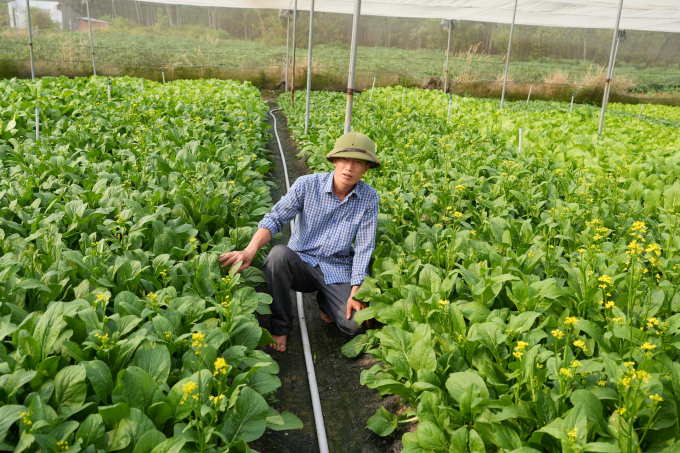
Nguyen Van Cong: "Vegetable model following VietGAP standards, but with higher quality than VietGAP". Photo: Hong Thuy.
“At that time, this area was full of vegetable gardens, but the local farmers including myself, not many people knew what VietGAP was. Therefore, vegetable growers keep fertilizing and spraying pesticides disorderly. I don't. Born in a poor farming family, I often go to the fields to help my parents, so I had a bit of knowledge on soil, crops, fertilizers and insects. I think the land I rent is quite favorable, as long as you know how to, you don't need to use much fertilizer. Pesticide is absolutely out of the question. While most people grow vegetables and bring them all to the wholesale market, my vegetables can be sold anywhere. In 2009, 2010, I planted 800m2 of vegetables and earned 2-3 hundred million a year. That's a huge amount of money", Cong said. "Why do they like your vegetables?", I asked. "They find my vegetables taste better, last longer. Besides, my vegetable garden is right next to the road, Every day a lot of people pass by, they also see that the way I do farming is unique. So even though the vegetables are not ready for harvest yet, they have already asked to buy and eat."
Thanks to the clean process of making vegetables, in 2010, Cong was the only person in a large vegetable growing area of the city who was sponsored to attend a professional class on making safe vegetables. Bringing the pipe to his mouth to smoke, tilting his head to exhale the smoke, Cong continued: "Thanks to the professional class, I got to meet and get acquainted with lecturers who are all professors and doctors, who know a lot more".
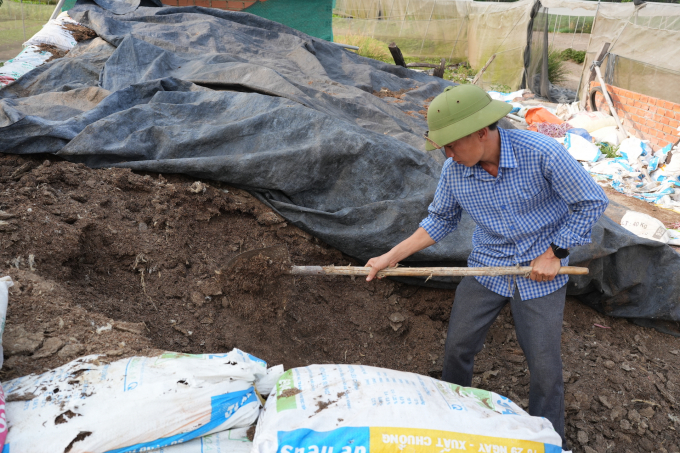
The model uses 95% organic fertilizers, with only 5% synthetic fertilizers. Photo: Hong Thuy.
Cultivation was favorable when the leased land is recovered for another project. At the time, Cong had not found new land to rent, so he had to do all kinds of oddjobs to earn money. Then, Cong received an invitation to work as a technical consultant on building a model of safe vegetable production in Bau Bang district, Binh Duong.
“When I received the invitation, I was very surprised, then asked again to find out, they contacted the teacher who taught me in the business class, then he refered to me and gave them my number. At that time, for each consulting project completed, they paid 15-20 million, this was the project's money funded by the state. Particularly in Bau Bang district, I consulted nearly a dozen cooperatives, but there are many individual households that I don't take money for individual counseling", Cong recalled.
Talking about the reason for living in Chon Thanh, Binh Phuoc, Cong said: "I worked in Bau Bang for a long time, I felt familiar, so I initially planned to borrow money and buy agricultural land there. But after thinking about it, if I bought the land right away and then followed the same thing as what I consulted the local farmers, I was afraid I would pressure them, so I put off that thought. After that, a few people whom I previously consulted, they introduced me here. I borrowed one hundred million from them each and bought 2 sao of land. The land is flat, but too bad, degraded, infertile, no plants can live, only ants". "So how did you fix it?" “It took me a lot of time and effort to give it life by spreading fertilizer, watering, planting grass. Only in 2018 did I officially invest in net houses and growing vegetables here.

Fertilizer is spread about 5cm above the ground and only applied once before planting until harvest. Photo: Hong Thuy.
The vegetable models of Cong as well as other cooperative members follow the VietGAP process but also have higher quality yields.
Cong uses hydrated lime to treat the soil, and for fertilizer, he uses 95% bio-composting manure but he does not fertilize the root directly, instead he spreads it on the ground first, then spread a thin layer of soil on the bed surface, and then plant the tree. The remaining 5% he uses synthetic fertilizers, applying when the vegetables are 5 days old. After which, fertilizer is not used again.
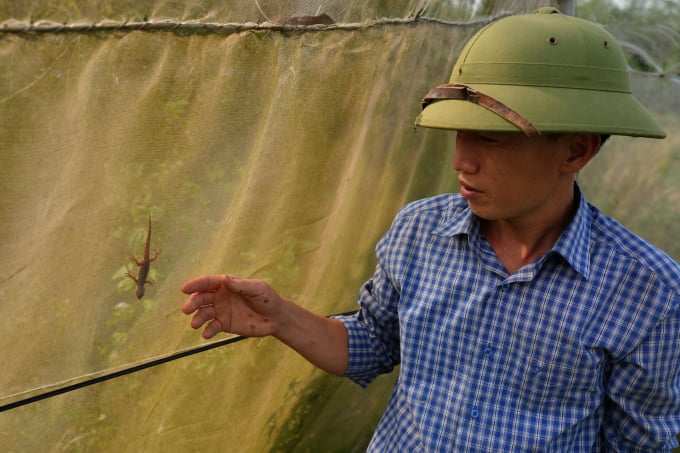
Gecko is one of the antagonistic creatures used to kill worms. Photo: Hong Thuy.
"What kind of chemicals do you use to treat pests?", I asked. “I do not use any chemical pesticides, only brewed probiotics, including chili, ginger, garlic, orange peel, tangerine, lemon and lemongrass. Another method I use is herbal essential oils mixed with water to spray on vegetables. These preparations, if they not killing the worms, they would scare worms with the smell. In addition, it has a reproductive inhibitory effect on some types of worms. As for the antagonistic organisms method, I have applied it for a long time and also advised many farmers to do it, it is very effective.
Following Cong to the greenhouse to find antagonistic organisms, I asked: "What are Cong's antagonistic organisms? Do they work?” I asked. Cong replied, "They are flower spiders, geckos and termite snakes. As I said, to treat pests without using chemical pesticides we must combine many solutions. Including antagonistic creatures. A little bit of everything.”
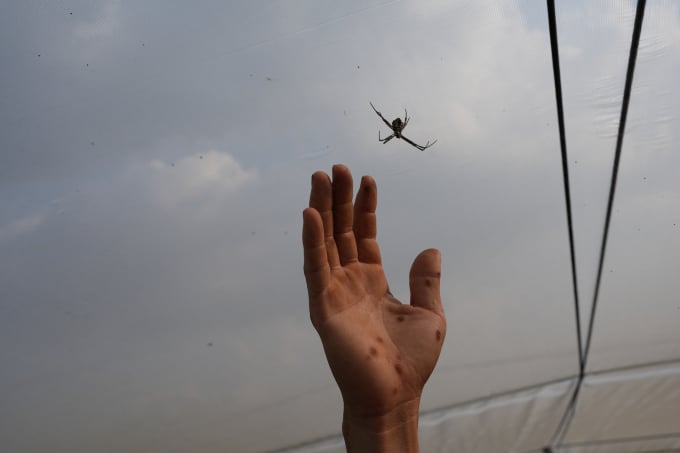
In the greenhouse, there are many flower spiders, the killer of many insects that harm vegetables. Photo: Hong Thuy.
As he spoke, Cong led me to the pillar in the corner of the greenhouse, then drew out the parts of the mesh coiled within the column, indeed, quite a few geckos were "hiding" inside, sensing movements, they scurried away. “It's day time, and it's so hot that they hide. There are a lot of them out at night," Cong said.
Continuing to walk around the net house, from time to time Cong would show me a flower spider lying dormant in the middle of the web. "This spider catches all kinds of insects including bees, butterflies, many beetles the size of a finger can't even escape after getting caught in its trap," Cong continued.
“If chemical pesticides are not used, then to treat pests, it is necessary to combine many solutions. Biological products have the main effect of repelling pests, not killing them. But there are other ways to limit worm infestation. For example, on an area growing the same vegetables, planting layers a few days apart, when detecting pests, I don't spray the entire plot, just the next plantings. Worms in the sprayed layer smell the pesticides, they will run to layers without pesticides to lay. But they will not have time to multiply and harm the vegetables because we would already have harvested. That's why people buy vegetables from time to time to find worms, or cook them up and find worms in the pot. In addition, crop rotation is an important solution to prevent pests and diseases, not chemicals.

Scallions are difficult plants to grow in hot climates and Cong is a fairly successful grower. Photo: Hong Thuy.
One of the difficult plants to grow in this area is scallion. Because this plant only grows well in cold climates, such as the North during Lunar New Year, or the Central Highlands provinces. Therefore, in Chon Thanh area, almost no gardeners grow scallions. But Cong succeeded in growing them.
“The hot climate all year round such as here makes it difficult to grow, scallions are difficult to grow, easy to die, or when mature, they often burn, leaves wither, unappealing. And as you can see, the scallions here are old but still very beautiful. I have a greenhouse, an irrigation system, knowledge of the technique, handle soil carefully and the seeds are brought from the North. Scallions in the North take 50 days to harvest, and here they take longer, about 2 months. My scallions are better than market ones, sweet, fragrant, spicier and last longer. Therefore, scallions sell for 30,000 to 35,000 VND/kg, while scallions in the market are only 15-20 thousand VND/kg”, Cong said.
From only 2 empty hands, he had to borrow money to buy land, as for accommodation, he even had to ask his friends to help build a temporary house. Now the couple's land from 2 sao has brought in another 6 sao. Cong said, now he can afford to build a house under 1 billion dong.
Translated by Nguyen Hai Long
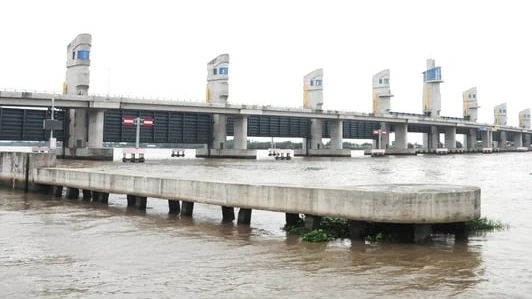
(VAN) Large-scale irrigation projects in the Mekong Delta have safeguarded a beneficiary area spanning more than 1 million hectares, significantly mitigating damage caused by drought and saltwater intrusion.

(VAN) Residents along the south bank of the Hau River are anticipating the Rach Mop lock by the end of 2024, along with projects to fortify the irrigation system to prevent saltwater intrusion.
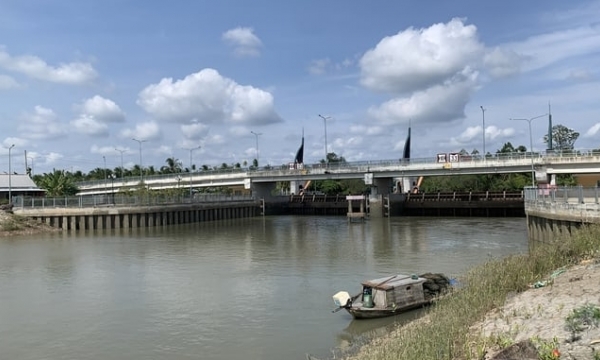
(VAN) The Bong Bot - Tan Dinh sluice delivers fresh water to meet the production demands of thousands residing in Tra Vinh province's coastal areas.
/2024/04/26/0500-3-135847_403.jpg)
(VAN) According to Dr. Dao The Anh, if indigenous varieties that are highly nutritious and adapt to climate change can be developed, the community will greatly benefit.
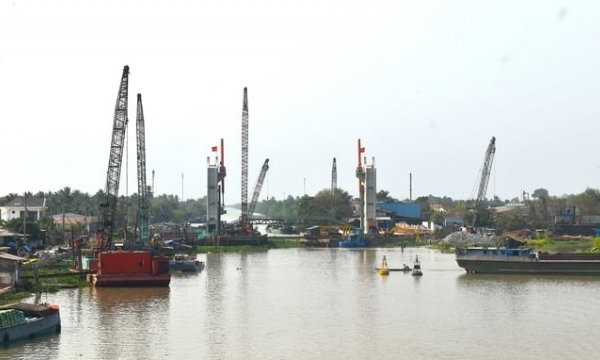
(VAN) The Nguyen Tan Thanh sluice is crucial in preventing salinity and storing freshwater to meet the daily needs of over 1.1 million residents in Tien Giang and Long An provinces.
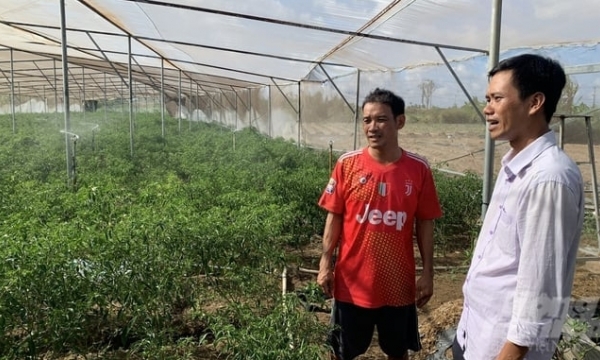
(VAN) The project, sponsored by the European Union, is implemented in Dong Thap, Kien Giang, and Tra Vinh provinces, with a total funding of 4.2 million Euros.
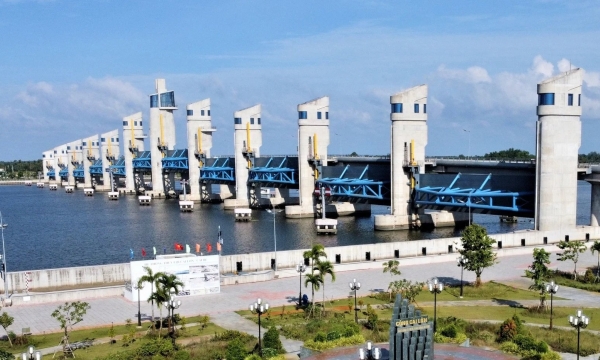
(VAN) In the heart of the Mekong Delta, the Cai Lon and Cai Be sluice gates act as guardians, halting the incursion of salty tides deep into the inland fields and managing freshwater resource distribution.